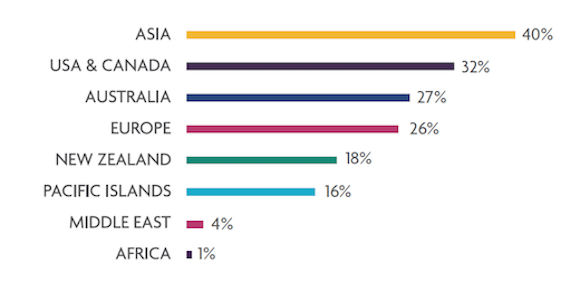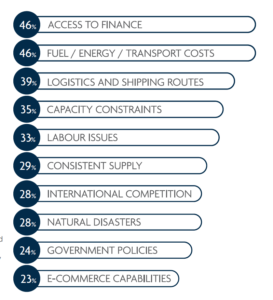The Pacific Islands Export Survey 2018, has found that 70 per cent of Pacific Island exporters expect to have an increase in orders over the next year. The survey, conducted by Pacific Trade Invest, found that Australia and New Zealand remain the two major markets in the region, although there is growing interest in Asia.

Most preferred new markets for Pacific Island exporters Source: Pacific Islands Export Survey
The survey found that 63 per cent of exporters receive export revenue from Australia (up from 55 per cent in 2016) and 49 per cent from New Zealand (up from 47 per cent in 2016).
Thirty one percent per cent of respondents export to the United States and Canada, followed by Europe, ‘other Asia’, Japan, China and Latin America.
Intra-regional trade is often the starting point for PNG exporters, according to the report. Two out of three exporters are generating orders from within the Pacific.
‘Exporters tend to look locally first.’
‘Fiji was the most popular destination, followed by: Vanuatu, New Caledonia, Solomon Islands, Papua New Guinea and Samoa.’
Intra-regional trade

UNSW’s Tim Harcourt
According to Tim Harcourt, JW Neville Fellow in Economics at UNSW Sydney, exporters tend to look locally first.
‘Pacific-based exporters, in general, use intra-regional trade to get their sea legs as an international exporter before expanding to Australasia, Asia and beyond,’ he says.
‘Just as the Pacific continues to play its key role as a “nursery” for Australian and New Zealand exporters, Pacific exporters are also finding the trans-Tasman economies to be their happy hunting ground.
‘Australia and New Zealand are the key export markets for Pacific Island exporters with 92 per cent of exporters regarding them as main destinations.
‘Access to finance is still the greatest barrier to export.’
‘But intra-regional trade is growing too, with two out of three businesses trading within the region.’
Barriers
The report found there are differing approaches to digital strategy, depending on the industry sector.
Online channels are used by 91 per cent of tourism exporters. Mature exporters and agricultural exporters, however, are less likely to use social media channels and other forms of e-commerce.

Main Barriers to exports Source: Pacific Islands Export Survey
‘Access to finance is still the greatest barrier to export, despite falling over the past two years,’ the report says.
‘High fuel and energy prices and transport costs are on the rise and this is closely associated with challenging shipping and logistics that exporters in the Pacific must tackle.
‘There have also been capacity constraints and the ongoing impact of natural disasters.
‘Government policies are seen as less of an obstacle.’
New exporters
Harcourt says the proportion of new exporters (those who started exporting in the past three years) has risen to 41 per cent, up from 31 per cent in 2014 and 38 per cent in 2016.
‘They are generally mature businesses, though new to export.
‘The growing proportion of new exporters is driving confidence in the 22 countries that make up the Pacific.’
The report says 51 per cent of agricultural and manufacturing exporters saw an increase in orders, followed by 45 per cent for tourism and 32 per cent for services.
‘Many exporters are looking for agents, joint venture partners and access to grants.’
Harcourt says tourism and manufacturing are ‘more bullish’ than either agriculture or services.
‘Exporters are innovative and proactive in finding new ways to boost sales,’ he says.
‘According to the survey, 43 per cent of exporters developed new products and services for export markets, enhanced marketing through online channels and improved efficiency through improved business processes.’
Harcourt says many exporters are looking for agents, joint venture partners or access to grants.
‘A majority (56 per cent) would welcome foreign investment in their business. Most need assistance with marketing their business (50 per cent), 40 per cent suggested better marketing of the Pacific was needed and 46 per cent wanted help with introductions to overseas customers.’








Speak Your Mind